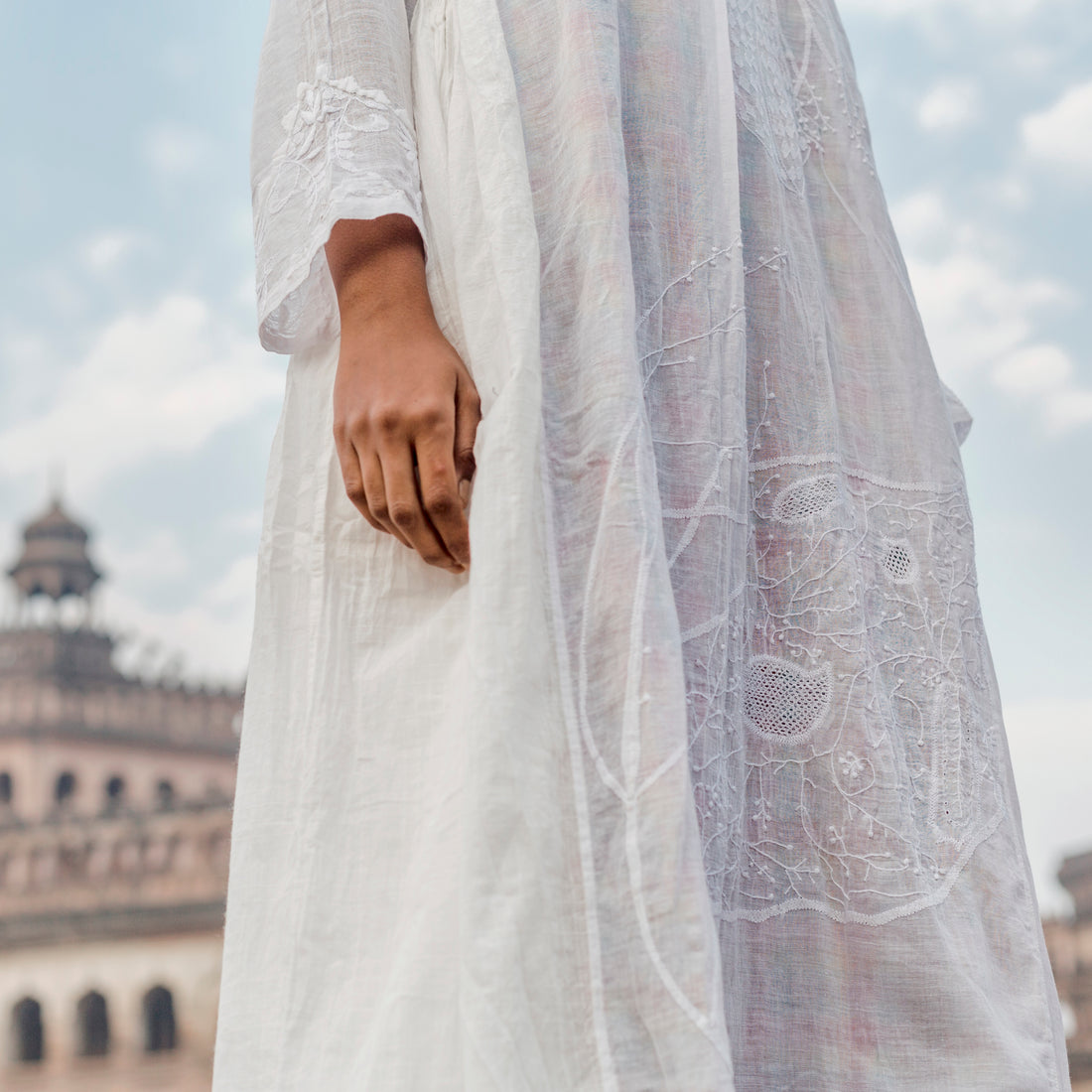
Music of Muslin
Injiri celebrates the quiet beauty of jamdani and chikankari
Guest edited by Chinar Farooqui of Injiri
Whether brocade woven, embroidered, or unadorned, muslin has enticed everyone interested in handmade, artisanal excellence and history.
Originally from Dhaka, Bangladesh (then India), this famous and fascinating fabric, muslin, was once no less than a treasure. Known worldwide for its fine texture and easy fall, muslin was loved for its supple, flowing quality. It is woven using the plain weave structure, in which a single weft thread alternates over and under a single warp thread. Muslin fabric was often referred to locally as Baft Hawa, woven air, and Abrawan, flowing water.

Chikankari probably originated in Calcutta and Dacca among Bengali embroiderers, perhaps as an alternative to jamdani; sometimes, the designs are almost indistinguishable. Both chikankari and jamdani are shadow-work, done white on white. This art form enjoyed patronage from the Mughals, under whom muslin, jamdani, and chikankari reached unprecedented standards of excellence.
Injiri, the brand launched by Chinar Farooqui in 2009, has collaborated with the jamdani weavers for the past 14 years. Farooqui's 2010 visit to Ghoranash, in West Bengal, marked the initial phase of developing yardage. This technique is primarily used for sarees where its loose structure is an asset. When Farooqui started working with jamdani, it was a challenge to construct garments from such fine cloth, so she spent three years collaborating with the weavers to develop a more tightly structured, stronger cloth that could withstand the rigour of stitched garments without compromising on its weight and handle. The weavers found the task challenging but eventually triumphed. Initially, the designs were limited to simple borders; however, they have since progressed to integrating more intricate and labour-intensive patterns into the work.
Want to read more of this article?
We are proud to be a subscriber-funded publication with members in 185 countries. We know our readership is passionate about textiles, so we invite you to help us preserve and promote the stories, memories, and histories that fabric holds. Your support allows us to publish our magazine, and also ‘what's on’ information, and subscription interviews, reviews, and long-read articles in our online blog.
ALREADY A SUBSCRIBER? CLICK HERE TO ACCESS CONTENT
OR...to continue reading….

*Magazine subscribers automatically get free access to all our online content. We send the access code by email with the publication of each issue. You will also find it on the envelope containing your magazine. Please note the access code changes every issue.*
Guest edited by Chinar Farooqui of Injiri
Whether brocade woven, embroidered, or unadorned, muslin has enticed everyone interested in handmade, artisanal excellence and history.
Originally from Dhaka, Bangladesh (then India), this famous and fascinating fabric, muslin, was once no less than a treasure. Known worldwide for its fine texture and easy fall, muslin was loved for its supple, flowing quality. It is woven using the plain weave structure, in which a single weft thread alternates over and under a single warp thread. Muslin fabric was often referred to locally as Baft Hawa, woven air, and Abrawan, flowing water.

Chikankari probably originated in Calcutta and Dacca among Bengali embroiderers, perhaps as an alternative to jamdani; sometimes, the designs are almost indistinguishable. Both chikankari and jamdani are shadow-work, done white on white. This art form enjoyed patronage from the Mughals, under whom muslin, jamdani, and chikankari reached unprecedented standards of excellence.
Injiri, the brand launched by Chinar Farooqui in 2009, has collaborated with the jamdani weavers for the past 14 years. Farooqui's 2010 visit to Ghoranash, in West Bengal, marked the initial phase of developing yardage. This technique is primarily used for sarees where its loose structure is an asset. When Farooqui started working with jamdani, it was a challenge to construct garments from such fine cloth, so she spent three years collaborating with the weavers to develop a more tightly structured, stronger cloth that could withstand the rigour of stitched garments without compromising on its weight and handle. The weavers found the task challenging but eventually triumphed. Initially, the designs were limited to simple borders; however, they have since progressed to integrating more intricate and labour-intensive patterns into the work.
Want to read more of this article?
We are proud to be a subscriber-funded publication with members in 185 countries. We know our readership is passionate about textiles, so we invite you to help us preserve and promote the stories, memories, and histories that fabric holds. Your support allows us to publish our magazine, and also ‘what's on’ information, and subscription interviews, reviews, and long-read articles in our online blog.
ALREADY A SUBSCRIBER? CLICK HERE TO ACCESS CONTENT
OR...to continue reading….

*Magazine subscribers automatically get free access to all our online content. We send the access code by email with the publication of each issue. You will also find it on the envelope containing your magazine. Please note the access code changes every issue.*
